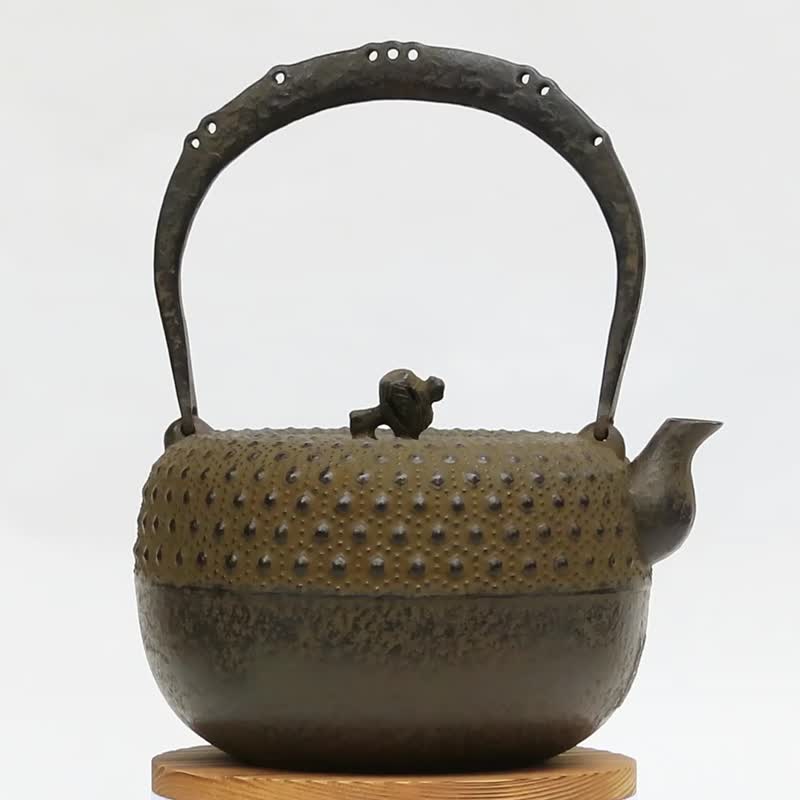※Due to the hand-coloring process, there are individual differences in coloring.
Each piece is carefully finished using traditional techniques.
Beautifully finished tetsubin.
This tetsubin is decorated with a traditional tortoise shell pattern.
The tortoiseshell pattern imitates the hexagonal pattern of a turtle's shell, symbolizing longevity and prosperity.
It is a traditional pattern that has been used on tetsubin since ancient times as a good omen.
The rim of the lid is also decorated with an tortoise shell pattern.
The plucking on the lid is designed with a 「treasure gavel」 a symbol and good luck charm that brings wealth to Daikoku-sama.
Daikoku-sama is one of the seven gods of good fortune in Japan, and is believed to be the god of prosperity and fertility.
Based on the legend that 「the more you strike, the more treasure comes out」 the treasure gavel is believed to bring unlimited wealth and good fortune to its owner, and is valued when wishing for prosperity in business.
This tetsubin with a treasure gavel design on the lid pick is made with the hope that it will bring good fortune and prosperity to the owner.
The treasure gavel lid knob is decorated with holes.
It creates a withered look and expresses Japanese 「wabi-sabi」, which is not only glamorous but also elegant.
「Wabi-sabi」 is an important concept that symbolizes Japanese culture and spirituality.
The handle is a flat oval shape made using a forging method.
A hole is drilled on the outside of the handle.
The handle produced by forging is a beautiful accent with a unique texture that further enhances the beauty of the tetsubin.
The handle is fixed.
The inside is finished with a rust-resistant finish using the traditional 「kama-yaki」 technique.
Kamayaki is done by firing the tetsubin in a high-temperature oven.
This process forms an oxide film on the surface of the tetsubin.
The oxide film stabilizes the iron content of the tetsubin.
The flavor of boiled water is improved and rust and corrosion are prevented.
Rust-proofing by kettle firing is a traditional technique that has been handed down since ancient times.
Natural lacquer baking finish on the outside.
Natural lacquer baking finish is a traditional method of applying natural lacquer to the surface of the tetsubin and firing it.
This process protects the surface of the tetsubin from rust and stains.
Natural lacquer is also highly durable and keeps the texture and color of the tetsubin beautifully for a long period of time.
The color is finished in a beautiful rusty color that expresses a vintage feel.
The capacity is approximately 1.5 liters, which is large enough to boil a lot of water.
Compatible with gas and induction cookers.
※Do not use on high heat.
Doing so may cause cracks or holes.
Artist Profile:Kiyoshige and Kiyosue、Foundry Artist Biography
Kiyoshige (3rd generation)
The name 「Kiyoshige」 was taken from the first character 「Kiyoshi」 of the first president, Yakichi Iwashimizu, and "Shigeru" of the nickname 「Shigekichi」 to create 「Kiyoshige」.
Currently, Kiyoshige Kiyoshige III is active in the company.
He produces a wide range of products from classic tetsubin tetsubin to tetsubin with a modern design to suit today's lifestyles.
Kiyoshige (Ryo Yaegashi)
1970: Born in Kitakami City, Iwate Prefecture.
1994: Joined Iwachu casting warks. Worked for Kiyoshige II and Kiyosue III (Shigeki Mizusawa).
2007: Served as the director of the Nanbu Tekki Cooperative Association.
2011: Certified as a traditional craftsman. (Became Kiyoshige III)
Kiyosue (4th generation)
Named after Iwashimizu Suekichi, the founder of Iwachu casting warks, and succeeded by his apprentice.
He succeeded to the name of Kiyosue IV.
He specializes in making small tetsubin, and has a wide range of pattern techniques, from detailed patterns to symbolic patterns.
Kiyosue (Shinichi Fujiwara)
1955: Born in Yakin, Iwate Prefecture.
1995: Joined Iwchu casting warks. Worked for the second and third generations of Kiyosue.
2012: Certified as a traditional craftsman. (Became the fourth generation Seisue.)
Manufacturer: Kiyoshige and Kiyosue
Size: W18 cm x D16 cm x H21.5 cm
Weight: Approximately 1.62kg
Capacity: Approximately 1.5L
Material: Iron casting
Country of manufacture: Japan (Iwate Prefecture)
Packaging form / accessories: Special box, instruction manual
Information on customs duties
Customs duty may be incurred when purchasing Japanese products from overseas.
We will enter a lower price for the item, but please note that the buyer will be responsible for any customs fees incurred.
Product Description
Product Details
- Material
- Other Metals
- How It's Made
- Handmade
- Where It's Made
- Japan
- Stock
- Down to the last 1
- Ranking
- No.8,139 - Kitchen & Dining | No.1,323 - Teapots & Teacups
- Popularity
-
- 372 views
- 0 have saved this item
- Product Type
- Authorized Representation
- Authorized By
- 南部鉄器
- Listing Summary
- This tetsubin is handmade by the foundry craftsman Kiyoshige and Kiyosue. Each piece is carefully finished using traditional techniques. This tetsubin is decorated with a traditional Nambu tetsuki tortoise shell pattern. The plucking on the lid is designed with a 「treasure gavel」 a symbol and good luck charm that brings wealth to Daikoku-sama.
Shipping Fees and More
- Shipping
- Payment method
-
- Credit/debit card payment
- Alipay
- Refunds & Exchanges
- Read more about refunds and exchanges
- Report
- Report this item













